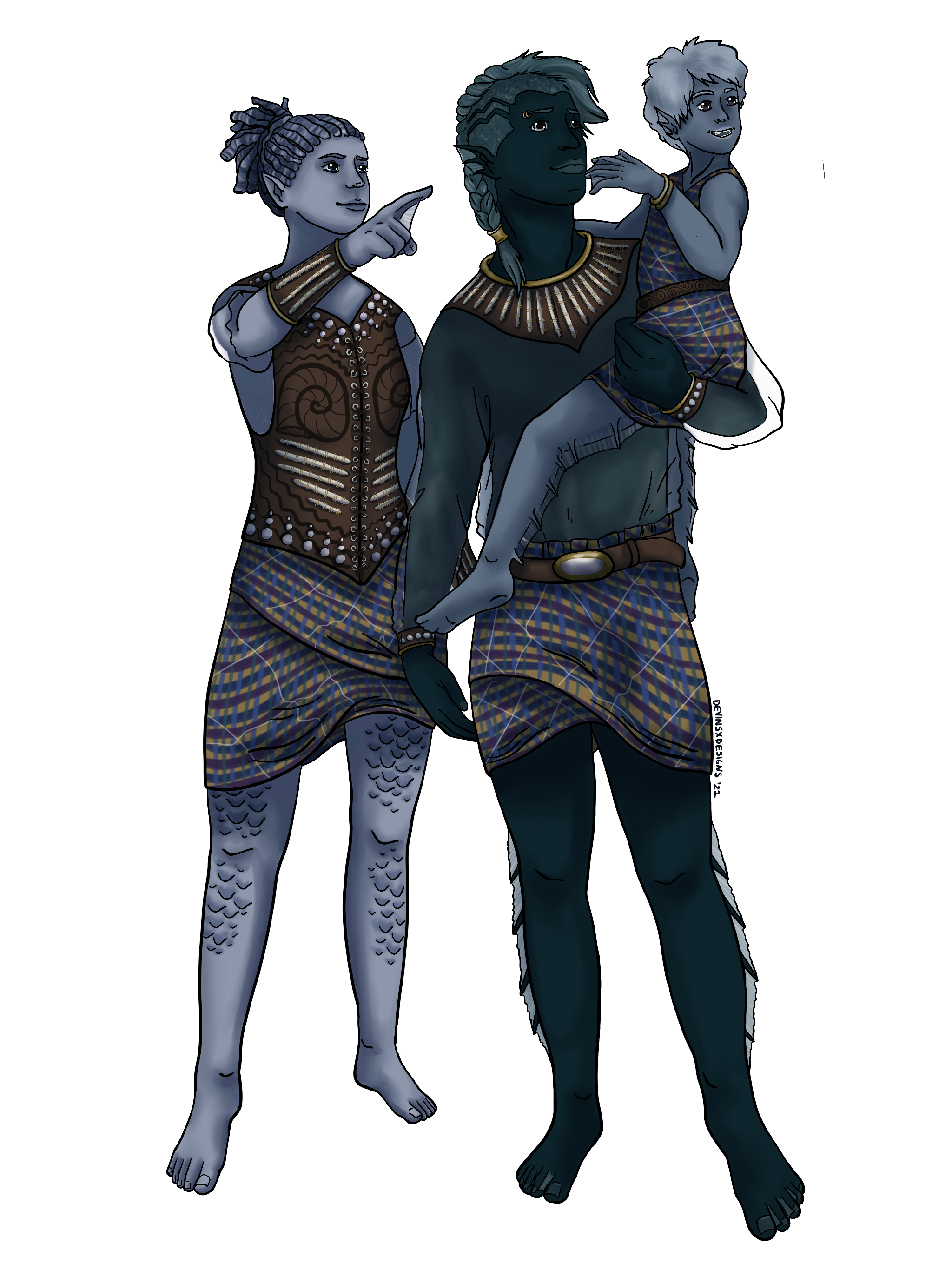Marelis
The Marelis are a semi-aquatic species who are found almost exclusively on Ryold. Marelis are, in a nutshell clamshell, people of the water. Present-day marelis are amphibious, but their history tells of a time when their ancestors lived mainly underwater, so their tendency to live on land is probably a choice.
Due to these reproductive processes, reproduction across species lines can be tricky for marelis. Mating interspecies between marelis and other sentient humanoids only results in a success about 50% of the time, even under ideal conditions; offspring can be mostly marelic, mostly the other parent, or a more homogenous mix but those who are an equal mix of both parents are often infertile entirely. Only male marelis can reproduce across species lines, because marelic hybrids do not survive to birth if transferred to a marelis womb, and must be incubated by the non-marelic parent. There are rumors of rare exceptions where a non-marelic male parent has managed to impregnate a hermaphroditic marelis and the offspring has survived to birth.
Biological Characteristics
Appearance
The marelis are bipedal, with facial and body features very similar to a human's. They tend to be similar in size to the humans, though they tend to be on the shorter side compared to their human cousins. They may or may not have some fish-like features such as fins (usually on the head, ears, back, wrists, or ankles), scales, or webbed hands and feet. Marelis eyes come almost exclusively in shades of blue and green, with occasional occurances of purple and gray. Their skin comes in shades of blue and green that can range from a very pale whitish-blue or whiteish-green to dark colors to rival the deepest depths of the oceans. Generally, a marelis' hair and aquatic characteristics (scales, webs, fins, etc.) are either a lighter or darker shade of the same color as their skin.Amphibious
Marelis are amphibious, able to breathe both air and water, but they do not have visible gills. Instead they have the ability to close off their trachea before it reaches their lungs, and they have internal gills lining their trachea and nasal passages.Aquatic Heritage
Thanks to their acclimation to living underwater, the marelis don't suffer negative effects from entering deep sea environments and are excellent swimmers. Most marelis also tend to be a little on the bulkier side, and it's because they still have a good layer of blubber under their skin, which also aids in their swimming abilities and protects them from cold water temperatures.Sensory and Extrasensory Capabilities
Marelis have adaptations to their five senses of sight, hearing, touch, taste, and smell that allow them to be amphibious, but some of which offer some slight disadvantage to land living. They have strong muscles around the eyes that allow them to change from a sperical shape (for air) to cylindrical (for water) and a large pupil for seeing in dark conditions. However, this leaves them disadvantaged in bright conditions, and often somewhat near-sighted. Their hearing is developed to be able to be used in air and water, but it is not especially good in either place; however, they have some measure of bone conductivity to assist their hearing and can, to an extent, echolocate. Their skin is extra sensitive and can give them some advantage in investigation by touch, even as far as navigating based on wind direction. Unfortunately, their soft skin is delicate and sensitive, leaving them extra sensitive to pain and while their skin heals fast, they often have many scratches and minor cuts and subsequent scars. Their sense of taste and smell tend to be somewhat muted, leaving them often searching for extra strong flavors and scents to compensate.Diet
The marelis are omnivores, but with a strong preference towards fish and shellfish over red meat. A vegetarian diet does not provide enough of the right nutrients for marelis to maintain their blubber layer.Genetics and Reproduction
While many of the marelic characteristics are similar to other aquatic mammals, they are most like fish when it comes to reproduction. Most (75%) of marelis have distinctly male or female sexual characteristics, while a rare few (15%) have no sexual organs and an even smaller number (10%) are hermaprodites who have both male and female sexual characteristics. Hermaproditic marelis can reproduce with other marelis of any gender, but cannot reproduce without a partner. Females create eggs, in groups of 1-3 per cycle, which must be fertilized by a male marelis, but they do not have wombs. Instead fertilized eggs are transferred to males to incubate, and the males do so in an external womb pouch similar to male seahorses. The male who incubates the eggs does not have to be the genetic father, and some male marelis are known to volunteer to incubate broods that aren't theirs, up to four eggs at a time, sometimes from different mothers at the same time.Due to these reproductive processes, reproduction across species lines can be tricky for marelis. Mating interspecies between marelis and other sentient humanoids only results in a success about 50% of the time, even under ideal conditions; offspring can be mostly marelic, mostly the other parent, or a more homogenous mix but those who are an equal mix of both parents are often infertile entirely. Only male marelis can reproduce across species lines, because marelic hybrids do not survive to birth if transferred to a marelis womb, and must be incubated by the non-marelic parent. There are rumors of rare exceptions where a non-marelic male parent has managed to impregnate a hermaphroditic marelis and the offspring has survived to birth.



Comments